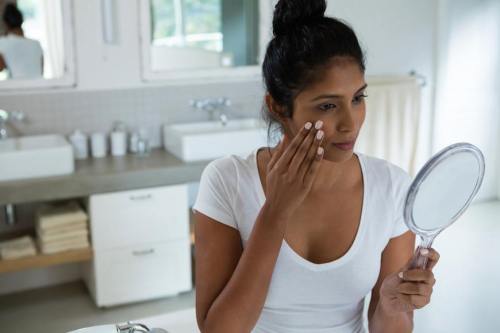When your skin’s upset, it can manifest its anger in various ways (much to our detriment). There are cysts, whiteheads, blackheads, and a slew of other forms of inflammation. One that doesn’t get talked about as much, though? Milia.
You may be familiar with the skin condition—it basically looks like teeny tiny bumps that are just below the surface. The thing is, your typical spot treatment doesn’t necessarily work for milia, which can make it even more mysterious. That’s exactly why I spoke with Sandra Lee, MD—AKA Dr. Pimple Popper—for some pro insight. (Yes, she’s popped plenty of milia before—enjoy if you so please.)
“Milia, or called milium if there’s only one, are very small superficial cysts that form just underneath the skin, most commonly around the eyes, which is the thinnest skin we have on the body,” says Dr. Lee, who has her own skin-care line SLMD Skincare. “They can form for a variety of reasons. They’re very common and some people are simply more prone than others—we even see some newborn babies born with milia.”
This Parisian Skincare Brand Is Launching in the United States for the First Time—Here’s What a Derm Wants You to Know

We’re Calling It: Cleansing Balms Are the Face Wash of the Future—Here Are 3 to Add to Your Cart

This Is the One Product That Scarlett Johansson Always Keeps in Her Purse and on Her Bedside Table

The bad news? “You can’t really treat milia at home or get rid of them yourself—they can’t be easily extracted without usually a small incision or nick in the skin. They’re completely harmless though, and don’t cause any irritation or pain, and usually they’ll go away on their own after some time.”
“Milia are very small superficial cysts that form just underneath the skin, most commonly around the eyes.” —Dr. Sandra Lee
That’s not to say you can’t try to speed up this process. Dr. Lee notes that the key is to use products that increase your cell turnover. “You can try to use topical exfoliants or retinol,” she says. “If they bother you and you want to remove them, a board-certified dermatologist can help to extract these pretty quickly and easily.”
Whatever you do, however, don’t play Dr. Pimple Popper with your milia at home. “You shouldn’t try to extract milia yourself,” she warns. “They’re not like a blackhead or whitehead and are actually under a layer of skin that requires incision to extract. Squeezing or scratching at them will increase your risk of infection and permanent scarring.”
To make sure you’re not doing anything that leads to milia, take special care to look at the ingredients of the skin-care products you’re using. “Just as it is with any type of acne, it can help to avoid occlusive, comedogenic products and stick with a good skin-care routine,” says Dr. Lee. “However, topical retinol or tretinoin used in the area can possibly decrease the chances of developing new ones in the future.” Mystery solved.
For intel on other skin woes, here’s how to treat hormonal acne. And this is how to get rid of acne scars, according to dermatologists.
Sign Up for Our Daily Newsletter
Get all the latest in wellness, trends, food, fitness, beauty, and more delivered right to your inbox.
Got it, you've been added to our email list.








